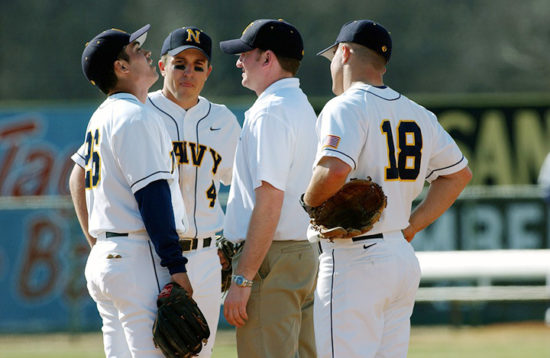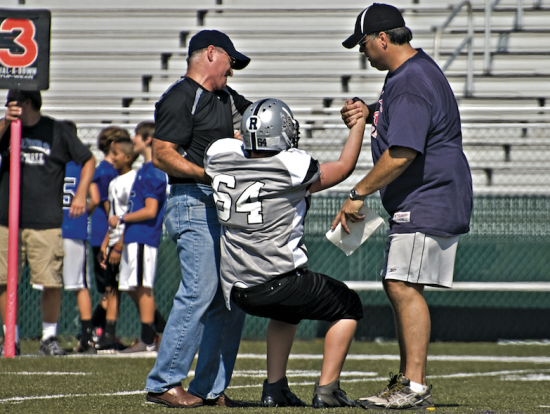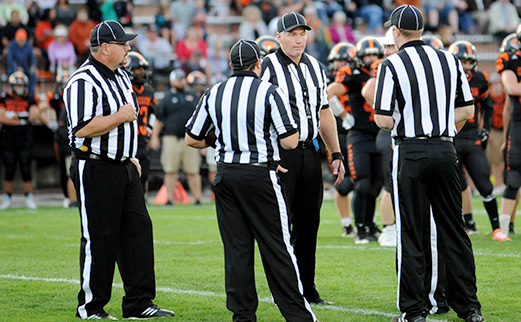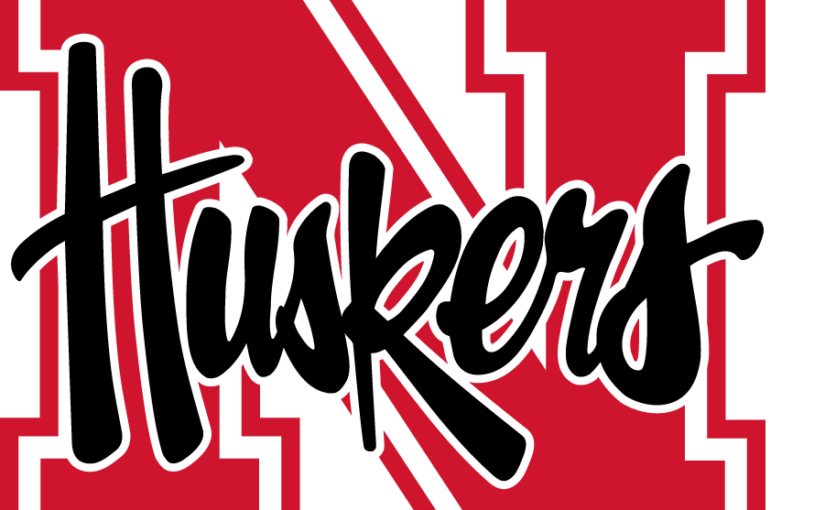Actionable ideas: Legal issues in athletics
Coach & Athletic Director recently asked readers to discuss the biggest legal issues and liabilities facing their departments, along with the steps they take to protect their schools. More than 70 coaches and athletic directors responded and the following represents the themes and topics most prevalent, as well as some interesting anecdotes.
Our main legal or liability issue at Capital High School in Montana is concussions. We have not had any legal problems yet, but it is on everyone’s mind. All our staff and parents know about the West Virginia Helmet Study, and they want the best helmets.
 Cost is a really big issue. The top helmets are very expensive, but it is what drives our budget and fundraising efforts.
Cost is a really big issue. The top helmets are very expensive, but it is what drives our budget and fundraising efforts.
— Pat Murphy, Capital High School, Helena, Mont.
Concussion management is the leading legal and liability issue facing programs across our state. We have a concussion management team, and we neurologically test all of our athletes. We try to get a baseline test set up for any head injuries that might occur. In the old days, if someone had a headache it was assumed they were just getting used to the helmet. A headache today can sideline athletes for days until a concussion is ruled out.
Everyone is cautious with all of the new legislation. Doctors, trainers and coaches have always done a great job, especially at the high school level, of identifying and helping student-athletes get back on their feet following head injuries. You no longer say, “he just got his bell rung” that would make you legally liable. A “bell-ringer” is a clear sign of trouble, and the athlete is automatically pulled from the contest for further evaluation. I’m not saying this is a bad thing, but it does put extra pressure on coaches, trainers and doctors to be careful before ruling out a head injury.
— Tim Seward, McGregor High School, McGregor, Texas
This topic and the responsibilities that go along with it are what give me gray hair. I must make sure my coaches are up to date with paperwork concerning themselves and the athletes. I also must make sure they complete the mandated courses on concussions and heat acclimatization. Their CPR/AAED certification must be current, and they are responsible for supervising their teams before and after practices. Today’s coaches need to be more than Xs and Os people.
Following up with them is my answer to dealing with the issue. Encouraging coaches to complete their requirements during the offseason, when there is down time, is strongly encouraged. My goal is to be proactive and not reactive.
— Michael Gelman, Randallstown High School, Randallstown, Md.
The main issue facing our school has to be concussions. No one has the answers, but parents are very concerned about their children’s safety and what the school is doing to prevent head injuries.
Our answer is having a tremendous training staff, which takes every precautionary step to inform our students and parents of the risks involved in extracurricular activities. Along with that, each athlete is baseline tested every other year to measure his or her response in the event of a head injury.
— Donald McKillip, Lockport Township High School, Lockport, Ill.
My biggest liability and concern as a high school football coach is most definitely head and neck awareness in the sport. Concussions and spinal injuries are always on our minds during every practice play and drill. We constantly stress proper form and technique to insure optimum safety of our student-athletes.
— Ryan Haughton, Fullerton High School, Fullerton, Neb.
The biggest issue is the missed practice time from an injury that ends up in ineligibility. In Indiana, if a student-athlete misses five to 10 consecutive practice days, they become ineligible until they can participate in four regularly scheduled practices. Consequently, if they missed more than 10 consecutive practices, they must participate in six practices to regain eligibility.
We have an athletic trainer visiting our school and practice sessions daily, in addition to working games, to help our athletes make a quick and safe recovery from injuries. We do not push our student-athletes back onto the practice field prior to them being ready and cleared. We spend our energy properly rehabbing our student-athletes back to health the right way, with guidance and support from the appropriate professionals.
This method has helped our student-athletes become stronger and healthier in the long run, as well as better educate them to help avoid future injuries.
— Mickey Golembeski, Providence High School, Clarksville, Ind.
The only thing that comes to mind is awareness with Title IX the law requiring you to treat female and male sports equally. It’s not something we have problems with, but it’s something you must always keep in mind as you make decisions dealing with budget, facilities, etc.
— Dewayne Richters, Marshall Independent School District, Texas
Concussions and injuries are the biggest issues. No matter how much concussion management training we provide there is always that athlete that slips through. This sometimes frustrates athletes, parents and coaches on the right course of action. It’s a two-way street for coaches. If you let them play, your job is in jeopardy, but if you sit them and the injury doesn’t appear significant, parents are in an uproar. Until there is a true way to diagnose a concussion, we always must be proactive and sit them when in doubt.
Also, it’s important to make sure tackling, wrestling and checking skills are properly taught. And now we have to add cheer stunts to the list.
— Steve Trifone, Cheshire High School, Cheshire, Conn.
 The main liability in most districts is the depletion of certificated and classified staff from an athletic and physical education standpoint. There are too many facilities that are not properly supervised by adult school employees, and this will be a major issue should any problem arise.
The main liability in most districts is the depletion of certificated and classified staff from an athletic and physical education standpoint. There are too many facilities that are not properly supervised by adult school employees, and this will be a major issue should any problem arise.
My other concern is the lack of school safety plans when classes are not in session. Site evacuation plans created for the school year, but there are many times when student-athletes are practicing with no emergency plans in place and no school administrative or certificated staff on duty. Coaches in this situation have limited if no access to many buildings and no predetermined evacuation procedures. I dealt with it by putting together my own emergency procedures, but was limited by my lack of resources and inability to access buildings for security purposes.
A head coach typically only has locker room and gym keys. It would probably be a good idea to give head coaches a master key, but I doubt that high-level administrators would receive this idea favorably.
— Rey Hernandez, Chula Vista, Calif.
The biggest issue facing coaches from a legal and professional standpoint is gaining support from administrators with respect to their policies. This has never affected me directly, but I have witnessed coaches face undue scrutiny and, in extreme cases, litigation. I believe all coaches must have their policies in writing, reviewed and signed by administrators, and distributed to parents at a meeting.
Coaches coach out of love for their sport and not the money. We all aspire to teach our athletes how to succeed in life. When we are undermined, we feel powerless. It’s best for all parties to be on the same page to do our most important job educate student-athletes.
— Kevin Weigand, Fort Myers, Fla.
Facilities are the main liability issue we are dealing with from an administrative standpoint. We are looking at creative avenues like grants and bonds to fund new facilities.
— Rick Dorn, Waterford School District, Waterford, Mich.
Our school’s main issue is providing an athletic trainer for our teams. There is no nearby hospital to provide a trainer for our school, so we have not had one for six or seven years. We have had some area hospitals offer services, but the cost is too great for our small school.
This puts a great amount of pressure on our coaching staff. The staff has done a great job educating itself, using caution when dealing with injuries and referring the athlete to a licensed doctor. We have been in contact with our local hospital and booster club to try and work out a compromise for a part-time trainer. We are hoping a deal can be reached and the legal burden on our coaches can be reduced.
— Bill Ball, Winamac High School, Winamac, Ind.
Concussion management is the No. 1 priority within our athletic department and football program. Though we have a comprehensive plan in place, we have added a few programs to further the safety of our athletes and coaches. We adopted the IMPACT test for all athletes in grades six through 12, with our certified athletic trainer administering a baseline test prior to participation. We also established a great relationship with a local concussion clinic, where athletes suspected of a concussion must go to be cleared.
Lastly, our coaches all take the free online course, “Concussions In Sports What You Need To Know,” offered by the National Federation of State High School Associations.
— Keith Kilmer, Lowell High School, Lowell, Ind.
By far the biggest hurdle is the use of social media and how it can negatively impact a team and the balance of the First Amendment. Courts around the nation have ruled that some things are protected speech and others are a detriment to a team environment and thus can be censored.
— Don Griswold, Keystone High School, LaGrange, Ohio
Transportation is one of the biggest issues I face. The school district wants to limit the number of meets we participate in, and for the ones they do fund we are limited as to how far we can travel. Since I want my teams to be competitive at the state level, there are certain types of meets they must compete in to gain experience needed to be reach their potential. That means I am forced to find alternative transportation.
We can’t afford to rent a bus for every meet. We resort to renting vans or having coaches use their personal vehicles to transport athletes. We even ask parents to drive their own children to events. This raises many legal concerns. Even the fact that I prefer to rent a van when traveling to the state meet causes an issue because the school has contracts with bus companies. That means we are forced to use a bus when a van would be considerably cheaper.
— Randy Wilson, Central Cambria High School, Edensburg, Pa.





